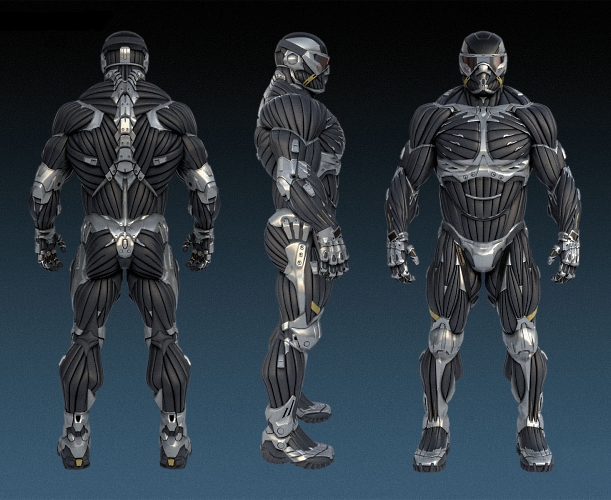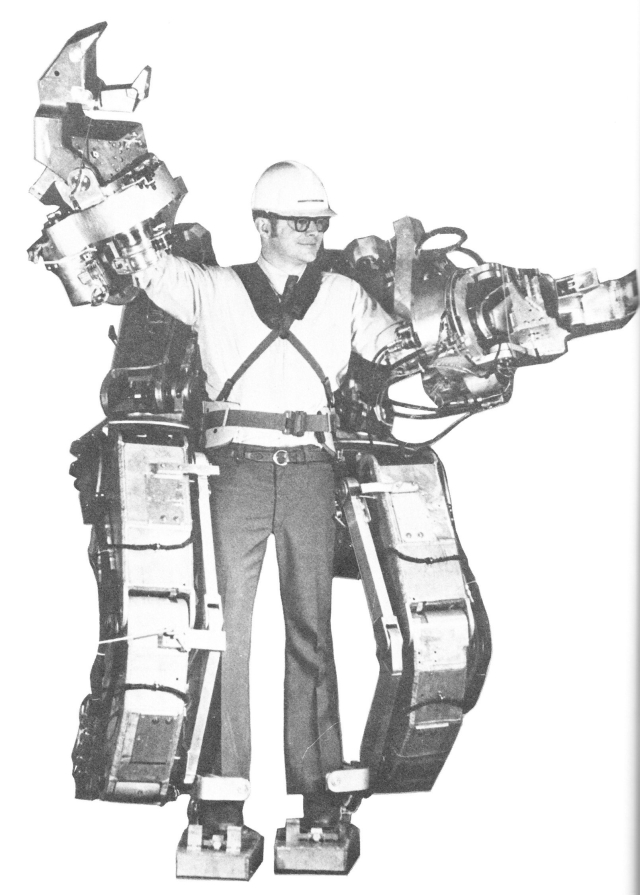Robots and exoskeletons seem to be in the news lately, considering that new CGI films can make it possible to show the hyper reality of what a sophisticated robot can do in a fire fight. The reality is far from the fantasy. As always movement is restricted by the limited technology, while electric motors rule the mini robots that dominate the toy shelves. The use of these motors will have a limiting strength with or with out a gear system.
 Consider The Hybrid Assistive Limb (also known as HAL) is a powered exoskeleton suit currently in development by Japan's Tsukuba University and the robotics company Cyberdyne. It has been designed to support and expand the physical capabilities of its users, particularly people with physical disabilities. There are currently two versions of the system: HAL 3, which has bulkier electric servo-motors and only has the leg function, and HAL 5, which is a full-body exoskeleton for the arms, legs, and torso. HAL 5 is currently capable of allowing the operator to lift and carry about five times as much weight as he or she could lift and carry unaided.
Consider The Hybrid Assistive Limb (also known as HAL) is a powered exoskeleton suit currently in development by Japan's Tsukuba University and the robotics company Cyberdyne. It has been designed to support and expand the physical capabilities of its users, particularly people with physical disabilities. There are currently two versions of the system: HAL 3, which has bulkier electric servo-motors and only has the leg function, and HAL 5, which is a full-body exoskeleton for the arms, legs, and torso. HAL 5 is currently capable of allowing the operator to lift and carry about five times as much weight as he or she could lift and carry unaided. When a person attempts to move their body, nerve signals are sent from the brain to the muscles through the motor neurons, moving the musculoskeletal system. When this happens, small biosignals can be detected on the surface of the skin. The HAL suit registers these signals through a sensor attached to the skin of the wearer. Based on the signals obtained, the power unit moves the joint simultaneously with the wearer's muscle movement, supporting and amplifying the wearer's motion. The HAL suit possesses both a user-activated “voluntary control system” and a “robotic autonomous control system” for automatic motion support. The use of biosignals from the limbs allows freedom of moment, as nerve impulses is greatly amplified to each servo motor joint. But while the elderly and other people with restricted movement are benefiting with this type of technology in Japan. The super human strength and speed and agility in such a machine with limited battery time can not out perform a robot attack.
When a person attempts to move their body, nerve signals are sent from the brain to the muscles through the motor neurons, moving the musculoskeletal system. When this happens, small biosignals can be detected on the surface of the skin. The HAL suit registers these signals through a sensor attached to the skin of the wearer. Based on the signals obtained, the power unit moves the joint simultaneously with the wearer's muscle movement, supporting and amplifying the wearer's motion. The HAL suit possesses both a user-activated “voluntary control system” and a “robotic autonomous control system” for automatic motion support. The use of biosignals from the limbs allows freedom of moment, as nerve impulses is greatly amplified to each servo motor joint. But while the elderly and other people with restricted movement are benefiting with this type of technology in Japan. The super human strength and speed and agility in such a machine with limited battery time can not out perform a robot attack.Consider hydraulic-power, in fluid or air used for the generation, control and transmission of power. Human Universal Load Carrier, or HULC, is an un-tethered, hydraulic-powered anthropomorphic exoskeleton developed by Professor H. Kazerooni and his team at Ekso Bionics. It is intended to help soldiers in combat carry a load of up to 200 pounds at a top speed of 10 miles per hour for extended periods of time. After being under development at Berkeley Robotics and Human Engineering Laboratory since 2000, the system was announced publicly at the AUSA Winter Symposium on February 26, 2009 when an exclusive licensing agreement was reached with Lockheed Martin.
Sensors in the foot pads relay information to an on-board microcomputer that moves the hydraulic system to amplify and enhance the wearer's movement. The flexibility of the system allows soldiers to run, walk, kneel, crawl, and even go into low squats. There is no joystick or control mechanism, instead sensors detect movement and, using an on-board micro-computer, make the suit move in time with the body. The system's titanium structure and hydraulic power augments the soldier's ability, strength and performance, whereas its modularity allows components to be switched and replaced with ease. Hydraulic power can provide speed and power to a human, but the large power pack even for a simple machine like the HULC system may limit its combat superiority. As the kicking power from this machine may provide enough damage to break bones, however it maybe top heavy. The likelyhood is that after attempting to kick the center of balance is distorted enough to topple over the user rendering him helpless as a turtle.
Current systems of actuators hydraulics and servo motors have strengths and weaknesses all of which seem to have limited success on mobile systems. Even for a exoskeleton system to win a bar room fight, punching and kicking movements would be slightly delayed, due to sluggish mechanics and electronics. Considering that a quick few punches is need to subdue your opponent.
Only recently the tiny artificial muscles created by an international team of researchers are 200 times stronger than human muscle fibers of comparable size. Ray Baughman, a nanotechnology researcher at the University of Texas at Dallas, led the team that made the new muscle, which he sometimes calls a yarn because of the way it's woven. The muscles would work well in small medical devices, he said. His lab in Texas has thought of another creative use for them, too: "We've been playing with yarns to open and close blinds depending on the temperature of the room," he told TechNewsDaily.
Baughman's new muscles are made of ropes of carbon nanotubes, a super-tiny, high-tech material that researchers are adding to everything from water filters to experimental airplane parts. Baughman said he and his team twisted the nanotubes "quite similarly to the way people insert twists into common wool or cotton fibers" into thicker yarns. They then filled the hollow space in the nanotubes with different materials, including paraffin, the wax that goes in candles.
To get the muscles to contract, researchers heated them briefly. When heated, the paraffin wax expanded, pushing against the nanotube walls and making them fatter and shorter. As the wax cooled again, it shrank, and the nanotubes became narrower and longer. The muscles were able to shorten and then lengthen again every 25 milliseconds, or 25 thousandths of a second, Baughman said. Such fast contractions mean the muscles are able to perform a lot of work, he said.
Right now, Baughman's lab knows how to make a muscle fiber that's one kilometer (0.62 miles) long, but Baughman hopes one day to weave fabrics that require miles of fiber. He also is looking to make the muscles react to chemicals instead of heat. Heat-driven motors are energy-inefficient, so chemical-driven muscles might be more practical.
 Alternatively SRI International, Menlo Park, Calif.created a electronic muscle or a passive dielectrics which are a variant of artificial muscle activated by the movement of electrons. In an actuator, two flexible conducting plates form a sandwich with the passive dielectric, a springy, insulating plastic, as a filling. When the plates are given opposite charges, their mutual attraction flattens and expands the filling.
Also electro active polymers already been reported to show a significant actuation strain, and although they were not strong enough to amplify body movements, they prove to be useful on small scale robotics.
Alternatively SRI International, Menlo Park, Calif.created a electronic muscle or a passive dielectrics which are a variant of artificial muscle activated by the movement of electrons. In an actuator, two flexible conducting plates form a sandwich with the passive dielectric, a springy, insulating plastic, as a filling. When the plates are given opposite charges, their mutual attraction flattens and expands the filling.
Also electro active polymers already been reported to show a significant actuation strain, and although they were not strong enough to amplify body movements, they prove to be useful on small scale robotics. Other alternatives might be a Ionic polymer metal composites are a form of artificial muscle that depends on the movement of ions for motion. Flexible metal foils sandwich a wet polymer filling. With the foils charged, free ions flow toward one side, expanding it and bending the actuator.
Its still early days for a practical actuator to replace the motors and hydraulics, that we have in current exoskeleton systems. Adding super strength to a machine would mean tethering it to a large power source. While agility of the human body cant quite be matched, as is unlikely at this time to see a exoskeleton perform the same movements of a gymnast.
Excluding the military applications of hand to hand combat or mimicking the fire power of fiction character Iron-man, although the real world applications for replacing damaged limbs is too important to miss. While electro-neural connections are becoming a reality. The progress for artificial muscles is quite slow in comparison to Moore's Law. As emerging technologies that are designed to replace the human element, so will those technologies will find a way to mimic muscle fibers or at-least replace electric servos. The end result will probably be a system that will help aid humans. While there might be a slight need for combat situations, its hard to think that there will be a suit or exoskeleton that will be able to perform superhuman martial arts on an opponent...











